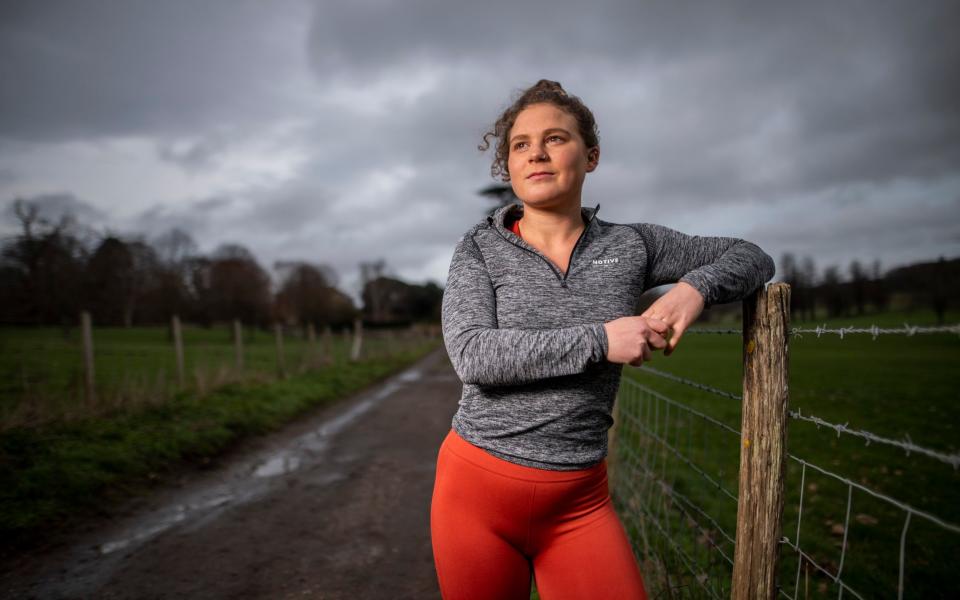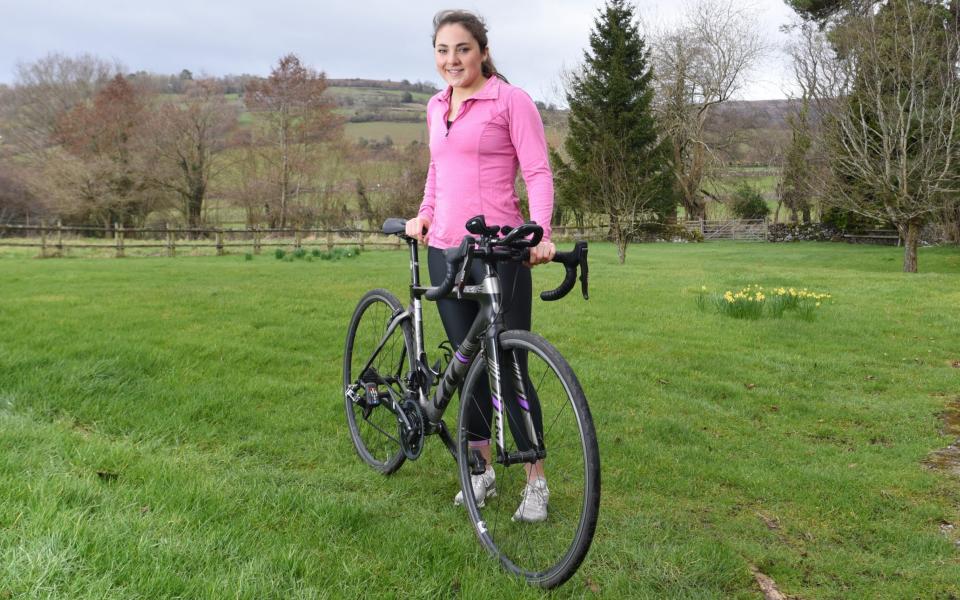Red-S: The little-known condition all athletes need to be aware of

When Dame Laura Kenny spoke last year about the number of sportswomen she knew who had struggled to get pregnant, it was one of the more sobering interviews Britain’s golden girl of cycling would give before calling time on her glittering career.
“We’ve all heard of Red-S – females losing their periods. You’re not going to be able to fall pregnant if you haven’t got a period,” Kenny, Britain’s most decorated female Olympian, said.
“It’s a really unhealthy lifestyle that these females can’t have kids, and it’s actually really sad.”
As she cradled her second son, Monty, Kenny went on to reference Red-S three times, describing it as “really dangerous” because of how it could severely impact a woman’s fertility. Kenny might have been well versed in the condition over the course of her athletic life, but knowledge of it across the sporting landscape remains worryingly scarce.
It stands for Relative Energy Deficiency in Sport and is a syndrome that has derailed – and continues to do so – the dreams of many sportswomen. Men can also experience the condition, which an athlete develops when they overtrain and under-fuel for a prolonged period.
Sometimes it can be unintentional – athletes simply do not realise they are eating insufficiently for the amount of energy being burnt. Other times, it can be exacerbated by “sports culture” and the perceived short-term performance gains of limiting calorie intake.
As well as affecting sports performance, the complex condition can impact a range of bodily systems, from reproductive health, cognitive function to impaired immunity. In women, one of the warning signs is the absence of periods, meaning the body has chronically low levels of oestrogen, the female sex hormone which is also crucial for bone density. Men can experience low testosterone and low libido.
‘We don’t think you should be doing sport’
Three years ago, Telegraph Sport interviewed two promising British athletes whose lives were unexpectedly turned upside down after they were diagnosed with Red-S. Bobby Clay and Issy Morris, a middle-distance runner and triathlete respectively, were national age-grade athletes with their best years ahead of them before discovering they had the condition.
Clay, a former European junior champion middle-distance runner, was a precocious talent who made Great Britain’s under-20 team when she was just 15. But three years later, her career came to an abrupt halt after she fractured her foot while kicking off the side of a swimming pool doing a tumble-turn. She was diagnosed with osteoporosis and put on hormone replacement therapy – usually used by older women to relieve the symptoms of the menopause – for more than a year to artificially induce periods.
Clay’s reproductive health has since improved. For the past two years, she has been having natural periods on a regular basis, but the invisible battle scars of Red-S are still there. “Bone-health-wise, I don’t think there’s been any improvement, but I’m in blissful ignorance now,” Clay says.
“I was working so hard with my rehab, everything in my body was telling me I was doing the right thing but I’d have a scan and a medical professional would say to me, ‘We don’t think you should be doing sport.’ The scores were never getting better, and I thought, ‘Do I really need this information?’”
Although she is still susceptible to stress fractures, Clay has her own holistic markers of success. Last summer, she completed an ultra-marathon, which provided the closure she craved seven years after her weakened bones gave up on her. “I never got to say goodbye to athletics,” she says. “One minute I was racing and on top of the world, and the next everything was gone. When I was training for the ultra, for the first time in my life running was a release and not a pressure. I was proud of just getting to the start line. Fuelling on my long runs became so normal. Food became a joy.”
Clay no longer wears a watch when she runs. Pace and other metrics have paled into insignificance. A near-fatal incident last October – when she was hit by a car while out on a run – also confirmed the 27-year-old’s body was more robust than scans might give her credit for. “Thank God my body withstood that,” reflects Clay, who fractured her lumbar spine in the accident. “The only reason it did, I’ve been told, was because I’ve spent so much time rehabbing and I’ve done the work in the gym. My musculoskeletal structure kept me together.”

‘I couldn’t motivate myself’
Like Clay, Morris started taking HRT aged 21 in a desperate attempt to reverse long-term hormonal damage as a result of eating too little for her training demands. She had developed osteopenia – the stage before osteoporosis – and was forced to take an indefinite break from triathlon. She recovered in time to represent Wales at the 2022 Commonwealth Games and Great Britain at the European Championships in Munich but, by that point, her battle to overcome Red-S had taken its toll. Months after reaching those highs, she stopped training altogether.
“I was absolutely hating it,” Morris says. “I couldn’t motivate myself. It took so much to get back from Red-S. I didn’t want to be a failed triathlete beaten by Red-S – that was my motivation and I felt like I’d achieved that.”
In a measure of how the recovery process from Red-S is highly individual, unlike Clay, Morris’ bone health has significantly improved. The osteopenia in her lumbar spine has since gone but she recalls one dark moment when a bone-density scan showed it was still present. “I broke down in tears,” Morris says. “I thought, ‘How have I still got it?’ When I had my first scan, I had it in my lumbar spine, left and right hip, but now it’s just in one hip.”
Morris, who completed her Masters in Sport and Exercise Nutrition this year, has launched her own nutrition business, I’m Set Nutrition, which aims to educate and advise those on adequate fuelling to support their energy expenditure demands.

“The biology lesson is that we need energy for everything, including your sport,” explains Dr Kirsty Elliott-Sale, a professor of female endocrinology and exercise physiology at Manchester Metropolitan University, speaking to Telegraph Sport at the 2024 Sport Accord conference in Birmingham. “When you’re redirecting energy to sport, some of the physiological systems say we don’t have enough to go round and one of the first systems to turn off is the reproductive system. The idea is, once you re-feed and have sufficient energy, the body should send that signal again to turn that system back on. But it isn’t exactly a switch and how long it takes is highly variable.”
The absence of periods (amenorrhea) has historically been identified as the first warning sign of Red-S, an alarm bell that should not be ignored. But Dr Elliott-Sale believes there are more forensic signs to help screen for Red-S, such as ovulation and monitoring levels of progesterone, the hormone produced by the ovaries that readies the body for pregnancy. “Those things give us a lovely package about menstrual health, which allows us to see someone go slightly off track before it’s amenorrhea,” she says.
In February, the International Federation of Sport Climbing became the first international sports governing body to introduce a comprehensive policy on Red-S, but awareness of the condition remains patchy.
Last summer, while attending the European Youth Olympic Festival in Maribor, Dr Niall Elliott, the head of sports medicine at the British Olympic Association, was shocked to discover the alarming number of medical professionals who appeared to know nothing about the syndrome. He recalls being in a committee meeting with medical consultants from national federations around the world.
“The head of the medical services asked how many of us had heard of Red-S,” he says. “About five of us in a room full of 50 put our hands up. There are consultants in hospitals who don’t believe Red-S exists. Is it taught at medical school? Not really.”
Calls are growing for GPs to have more knowledge of Red-S, which is often only diagnosed by sports clinicians. One recommendation put forward in the 2023 Athlete Health Report, published by Project Red-S and Kyniska Advocacy, was to create a resource for GPs to better understand the syndrome and, more generally, menstrual health. Of 796 sportswomen surveyed, 30 per cent had been told by a medical professional it was normal to miss their period, while a significant number highlighted a lack of understanding among healthcare professionals and coaches.
‘Nobody in the UK had an idea what it was’
When Pippa Woolven, a former British steeplechase runner, was diagnosed with Red-S in her mid-twenties after years of under-fuelling, having been sucked into a “clean eating” culture while on a running scholarship in the United States, she embarked on a long quest for answers. Rather than impaired bone health, which she experienced further down the line, her short-term symptoms ranged from chronic fatigue to mood swings and brain fog.
“I returned to the UK and nobody had any idea what this was,” says Woolven, who also went without a proper period for eight years. “My coach didn’t know, my doctor didn’t know. I was seeing endocrinologists and specialists all over the country and nobody could piece together the symptoms of this condition. Nobody really knew, we were kind of in the dark, trying to solve this problem.”
Woolven had spent years on the pill, which induces a monthly “withdrawal bleed” that, contrary to what many sportswomen believe, is not the same as a normal period and can mask cycle-related symptoms of Red-S. Like Clay and Morris, she started taking HRT and endured a three-year wait for her natural periods to return and counts herself as one of the lucky ones, having given birth to her first child, Allistair, last year.
“Had I wanted kids in my mid-twenties, there’s no way I would have been able to and then I would have been on a really stressful journey trying to regain my fertility in a race against time,” she says. “Athletes potentially retiring in their mid-thirties in a state of energy deficit having to repay that debt over time and get their health back is worrying.”
Woolven’s experiences led her to founding Project Red-S, an online resource which provides information about prevention and support for the condition.
On a weekly basis, she receives around 20 emails from athletes reaching out for advice. “It’s not just women but guys, too,” she says. “It’s been a mad insight into the scale of the problem. I think it’s getting worse and worse because of social media influencers – they’re not specialists and they’re not elite sportspeople – so, people are training like elite sportspeople without the medical support.”
It is why athlete testimonies from those who have been through the condition and come out the other side have never been so important. So, what would Clay and Morris say to those who might suspect they have Red-S and are worried about their fertility?
“Act early,” Morris says. “Because it’s hidden, things can happen without you knowing about it. There’s no point ignoring any signs you might have.”
Clay’s advice is simple yet poetic. “Accept who you are as a person, away from sport,” she says. “See yourself as a person rather than a vessel to do things. To be, rather than to do.”

 Yahoo Sport
Yahoo Sport 




































































